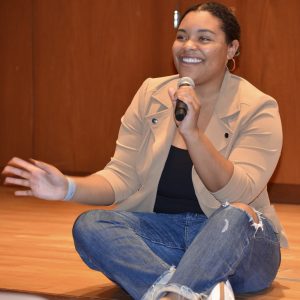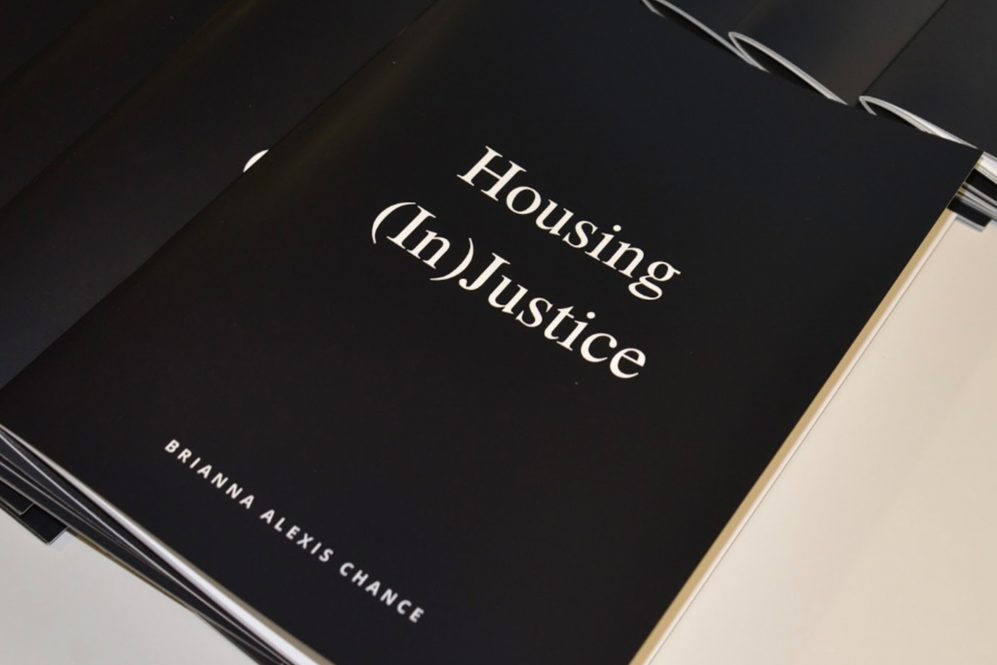During one of Brianna Chance’s shoots for her new docuseries project, “Housing (In)Justice,” earlier this year, a passerby asked what she was doing. When she told him that she was working on a series that would shed light on homelessness and housing insecurity for college students, he laughed.
“I asked, what’s so funny?” Chance ’23 (SFA, ED) recalls. “He said, ‘Well, when you think of homeless people, you think of people on the streets. I mean, college students aren’t homeless – they have dorms and apartments.’”
Though the comment stung, Chance knew better than to be upset with him. She supplied him with statistics and a Google Drive folder of her own research instead. (Dorms typically close for the summer and breaks, she reminded him—and during the height of the COVID-19 pandemic, many closed indefinitely.) And on Nov. 6, when she premiered “Housing (In)Justice” to an emotional audience in UConn’s Dodd Center for Human Rights, she let students’ stories speak for themselves.

Chance says she has encountered skepticism about student homelessness from all corners. Mainstream representations of homelessness that depict people living on streets or in shelters, combined with a lack of exposure to diverse stories, have fostered a widespread disbelief that the term could apply to college students. This doubt even impacts the students who are or have been homeless themselves.
“At one point I was like, did any of that even happen? Was I ever really homeless? I started to question my own experiences,” Chance says. “And this project cracked it open for me. It was like, no, all of that really did happen, but it felt like it didn’t because nobody was listening to you. That is what we’re trying to avoid.”
Knowing that she wanted to create a project that represented “an intersection of art and social justice,” Chance obtained funding and support from the BOLD Women’s Leadership Network to launch the documentary series. It was her first foray into filmmaking. With help from friend and fellow UConn filmmaker Isaiah Edwards ’21 (SFA), she quickly gained the camera savvy and editing know-how to produce her five-vignette series.
The project, which includes an accompanying standalone magazine, premiered on Nov. 6. Chance surprised viewers at the end – not even her closest friends knew that Chance herself was the subject of the fifth and final video in the series.
“It’s like someone’s worst nightmare to sit out there and tell everyone all the awful things that you’ve been through,” she says. “But I’m really glad that I did that, because I had asked other people to do it, so why couldn’t I do it? I need to be able to hold myself to the same standard emotionally that I’m holding other people to. And if I’m expecting vulnerability from others, you’d best believe I need to be practicing that emotional vulnerability as well.”
Combatting a Culture of Silence
The decision to include herself in the project was deliberate, if terrifying, says Chance. It was part of her commitment to breaking down the barriers to discussing student homelessness that exist on the societal as well as on the interpersonal level. During the production of this series, these barriers presented themselves in numerous ways.
First, according to Chance, a major chilling effect for students sharing their stories is that many simply aren’t aware that they have experienced housing insecurity. The lack of open dialog about the issue prevents these students from accessing language to describe their experiences or imagining community resources that could assist them. Instead, they stay engulfed in doubt and confusion — many just trying to keep their head above water day by day.
Chance discovered that the students she spoke to were better able to identify with the subject of housing insecurity when she asked them open-ended questions.
“It’s very difficult because people tend to sit there and they deny, deny, deny to themselves. But you’d be surprised, if you ask somebody a simple question — ‘Tell me what happened in your sophomore year with your housing’ — it all comes out,” she says.
But another barrier to open conversation is the social stigma attached to homelessness, which makes it even harder for students to discuss their experiences and ask for help.
“Even when you do know what housing insecurity is, there’s still that sense of you wanting to deny it because you don’t want to be seen as the person that doesn’t have a place to live. You don’t want to be stigmatized as the person who is sleeping in their car,” Chance says. “There’s a huge stigma surrounding it. So even if you know what those words mean, it’s not the first thing you talk about when you’re in a conversation with somebody.”
Repetition with a Difference
Chance said she was surprised by how all her narrators’ stories differed from each other, even as they bore key similarities. As the series developed, she realized that her fellow students and alumni weren’t telling the same story over and over — they were telling different parts of the same story, one that spanned generations and encompassed a diverse cosmos of backgrounds and perspectives.
“It was just so eye-opening to see that my story aligned with a lot of people’s in some ways,” Chance says. “Like the heartache and the pain that Teanna was feeling, I also felt, but then also the lack of resources and the lack of vocabulary and awareness about my situation was also felt through stories like Amber. Just seeing where those paths crossed, it kind of created this patchwork of narratives that I wasn’t expecting.”
The work was hard. Filming the interviews was intensely emotional and intimate, and at many points Chance realized that she “didn’t budget for” how heavy the process would be. Now, though, with the project wrapped and available to the public, she knows that it was worth it.
Raising awareness about student homelessness has the potential to demystify the issue and transform the way homeless and housing-insecure students reach resources and advance their education. Chance also hopes that seeing these stories onscreen will lessen the shame felt by these same students.
Finally, she hopes that “Housing (In)Justice” will clear up some misconceptions about student homelessness once and for all. Chance unflinchingly documents the lived reality of housing-insecure students, reminding viewers of the structural barriers to academic success – not to mention social and emotional wellbeing – these students continue to face.
UConn students facing housing insecurity or homelessness can reach out to the Dean of Students office or the Office of Residential Life to be connected with accommodations.



